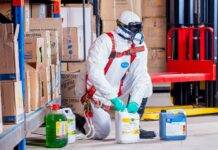
Control of Substances Hazardous to Health (COSHH)
Introduction to COSHH
Control of Substances Hazardous to Health (COSHH) is a crucial framework designed to protect individuals from the risks posed by hazardous substances in the workplace. Whether it’s chemicals, fumes, dust, or biological agents, COSHH guidelines aim to ensure safety by managing and controlling exposure.
Understanding Hazardous Substances
Hazardous substances encompass a wide range of materials that can pose risks to health and safety. These include chemicals, gases, and biological agents that, when not handled properly, can lead to various health issues ranging from skin irritation to severe respiratory problems.
COSHH Regulations and Compliance
The COSHH regulations set clear guidelines for employers and employees on how to handle hazardous substances safely. Employers are responsible for risk assessments, providing necessary training, and implementing control measures. Employees, on the other hand, are obliged to follow safety protocols.
Assessment of Risks
Conducting a thorough risk assessment is a fundamental step in COSHH. It involves identifying potential hazards, evaluating the risks associated with them, and implementing measures to mitigate these risks effectively.
Control Measures
Implementing control measures is crucial in minimizing exposure to hazardous substances. These measures can range from engineering controls to administrative controls and the use of personal protective equipment (PPE).
Personal Protective Equipment (PPE)
PPE serves as a last line of defense against hazardous substances. Choosing the right PPE and ensuring its proper use is essential in safeguarding against potential risks.
Handling and Storage of Hazardous Substances
Proper handling and storage of hazardous substances are vital to prevent accidents and exposure. Following prescribed guidelines for storage and handling minimizes risks significantly.
Emergency Procedures
Having well-defined emergency procedures is critical in case of accidents involving hazardous substances. Prompt and effective action during emergencies can mitigate the impact on individuals and the environment.
Training and Awareness
Educating employees about COSHH and providing regular training sessions increase awareness and compliance. Informed employees are better equipped to protect themselves and their colleagues.
Monitoring and Reviewing
Continuous monitoring and periodic reviews of COSHH measures ensure their effectiveness. It allows for adjustments and improvements in safety protocols.
Benefits of Compliance
Compliance with COSHH regulations leads to a safer work environment, reducing incidents of illnesses and injuries. It also enhances organizational reputation and productivity.
Common Misconceptions
Addressing misconceptions about COSHH is essential. Clearing up misunderstandings fosters better adherence to safety protocols.
Case Studies
Real-life examples illustrate successful COSHH implementation, highlighting best practices and lessons learned.
Future of COSHH
The landscape of workplace safety is evolving. Anticipated changes and improvements in COSHH aim to make workplaces even safer in the future.
Conclusion
Control of Substances Hazardous to Health (COSHH) plays a pivotal role in ensuring workplace safety. Adhering to its guidelines not only protects individuals but also contributes to a more productive and healthier work environment.
Why COSHH is Essential for Workplace Safety
COSHH (Control of Substances Hazardous to Health)
Chemical Safety Toolbox Talk Meeting
FAQs
- Why is COSHH important in workplaces?
- COSHH ensures the safe handling of hazardous substances, reducing health risks for employees.
- Who is responsible for COSHH compliance?
- Employers are primarily responsible, overseeing risk assessments and safety measures. Employees must follow protocols.
- What are some common control measures under COSHH?
- Control measures include engineering controls, administrative controls, and the use of personal protective equipment (PPE).
- How often should COSHH measures be reviewed?
- Regular reviews are crucial; typically, these should be conducted at least annually or when there are changes in work processes or substances used.
- What are the long-term benefits of COSHH compliance?
- Compliance leads to a safer work environment, reduced incidents, improved employee health, and enhanced organizational reputation.
Control of Substances Hazardous to Health (COSHH)
Introduction to COSHH
Control of Substances Hazardous to Health (COSHH) is a crucial framework designed to protect individuals from the risks posed by hazardous substances in the workplace. Whether it’s chemicals, fumes, dust, or biological agents, COSHH guidelines aim to ensure safety by managing and controlling exposure.
Understanding Hazardous Substances
Hazardous substances encompass a wide range of materials that can pose risks to health and safety. These include chemicals, gases, and biological agents that, when not handled properly, can lead to various health issues ranging from skin irritation to severe respiratory problems.
COSHH Regulations and Compliance
The COSHH regulations set clear guidelines for employers and employees on how to handle hazardous substances safely. Employers are responsible for risk assessments, providing necessary training, and implementing control measures. Employees, on the other hand, are obliged to follow safety protocols.
Assessment of Risks
Conducting a thorough risk assessment is a fundamental step in COSHH. It involves identifying potential hazards, evaluating the risks associated with them, and implementing measures to mitigate these risks effectively.
Control Measures
Implementing control measures is crucial in minimizing exposure to hazardous substances. These measures can range from engineering controls to administrative controls and the use of personal protective equipment (PPE).
Personal Protective Equipment (PPE)
PPE serves as a last line of defense against hazardous substances. Choosing the right PPE and ensuring its proper use is essential in safeguarding against potential risks.
Handling and Storage of Hazardous Substances
Proper handling and storage of hazardous substances are vital to prevent accidents and exposure. Following prescribed guidelines for storage and handling minimizes risks significantly.
Emergency Procedures
Having well-defined emergency procedures is critical in case of accidents involving hazardous substances. Prompt and effective action during emergencies can mitigate the impact on individuals and the environment.
Training and Awareness
Educating employees about COSHH and providing regular training sessions increase awareness and compliance. Informed employees are better equipped to protect themselves and their colleagues.
Monitoring and Reviewing
Continuous monitoring and periodic reviews of COSHH measures ensure their effectiveness. It allows for adjustments and improvements in safety protocols.
Benefits of Compliance
Compliance with COSHH regulations leads to a safer work environment, reducing incidents of illnesses and injuries. It also enhances organizational reputation and productivity.
Common Misconceptions
Addressing misconceptions about COSHH is essential. Clearing up misunderstandings fosters better adherence to safety protocols.
Case Studies
Real-life examples illustrate successful COSHH implementation, highlighting best practices and lessons learned.
Future of COSHH
The landscape of workplace safety is evolving. Anticipated changes and improvements in COSHH aim to make workplaces even safer in the future.
Conclusion
Control of Substances Hazardous to Health (COSHH) plays a pivotal role in ensuring workplace safety. Adhering to its guidelines not only protects individuals but also contributes to a more productive and healthier work environment.
FAQs
- Why is COSHH important in workplaces?
- COSHH ensures the safe handling of hazardous substances, reducing health risks for employees.
- Who is responsible for COSHH compliance?
- Employers are primarily responsible, overseeing risk assessments and safety measures. Employees must follow protocols.
- What are some common control measures under COSHH?
- Control measures include engineering controls, administrative controls, and the use of personal protective equipment (PPE).
- How often should COSHH measures be reviewed?
- Regular reviews are crucial; typically, these should be conducted at least annually or when there are changes in work processes or substances used.
- What are the long-term benefits of COSHH compliance?
- Compliance leads to a safer work environment, reduced incidents, improved employee health, and enhanced organizational reputation.
























